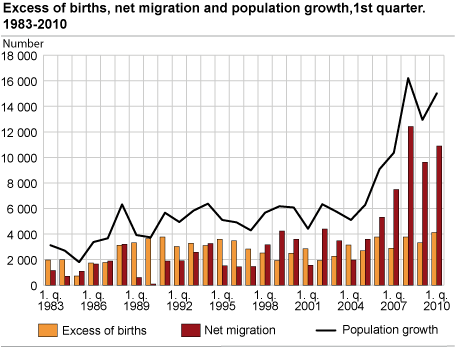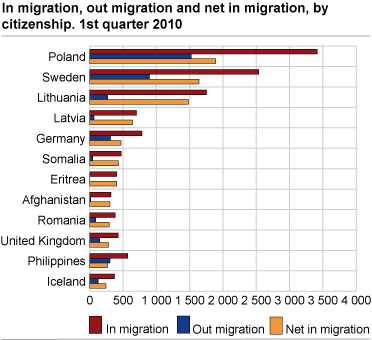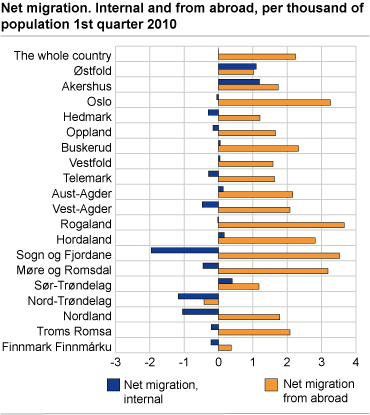Content
Published:
This is an archived release.
Highest birth surplus in 36 years
Norway's population increased by 15 000 to 4 873 000 in the first quarter of 2010. The population increase was 2 100 higher than in the same period last year. This was due to the high birth surplus and a larger immigration than in any previous first quarter.
The immigration surplus from abroad in the first quarter, 10 900, made up three quarters of the population increase. Immigration totalled 19 100 in the first quarter, 2 500 more than last year, and the highest number ever recorded in a first quarter. A total of 8 200 persons emigrated, 1 250 more than last year, and this was also the highest number ever recorded. The resulting net migration of 10 900 was second only to the one in 2008. During the 1990-2007 period it varied from 100 to 7 500.
A total of 15 000 children were born, 150 more than last year, and this was the highest figure since year 2000. A total of 10 900 died, 650 fewer than in 2008, and with the exception of 2006, this was the lowest number of any first quarter since 1984. The resulting birth surplus of 4 100, which was 800 or 24 per cent higher than last year, was the highest registered since 1974.
Increased Baltic immigration
Polish citizens still constitute the largest group of immigrants. Some noteworthy changes could be seen in the immigration pattern of the first three months.
A total of 2 500 Swedish citizens arrived in the first quarter, and this was 850 or 50 per cent more than last year. Nine hundred Swedish citizens emigrated, and this resulted in a net immigration of 1 600, towards 950 last year. A total of 1 800 Lithuanian citizens arrived, twice as many as in 2009. Only 300 emigrated, resulting in a net immigration of 1 500, whereas last year it stood at only 600.
Latvian citizens made up the fourth largest group this year, and for the first time were to be found on the list of the countries from where most immigrants came. Immigration by Icelandic citizens also increased, from 250 last year to 400 this year. Refugees showed differing developments. Net immigration among Somali citizens doubled from 200 last year to 400 this year, whereas net immigration by Iraqi citizens decreased from 300 last year to 150.
Population increase in all counties except one
The four counties Oslo, Akershus, Rogaland and Hordaland represented 9 700 or 65 per cent of the total population increase in the country. Only Nord-Trøndelag experienced a decrease, but this was due to the registered emigration of 200 Polish citizens from Verran municipality.
Highest natural increase in Oslo
Oslo also stood out as regards excess of births over deaths in the first quarter of 2010, which reached 1 300 or almost a third of the total excess of births in the country. Four counties had a deficit of births over deaths.
Migration gain from abroad
Eighteen of the counties, as in previous years, had a migration gain from abroad. The only county without a migration gain was Nord-Trøndelag, for reasons previously explained. The two counties Oslo/Akershus on the one hand and Rogaland/Hordaland combined on the other, had the largest gains, with almost 3 000 each. The migration gain totalled 10 900 and offset the birth deficit and domestic migration loss in many counties.
Twelve counties had a domestic migration loss, whereas seven had a domestic migration gain, the largest of which were in Østfold and Akershus.
Population increase in 268 municipalities
A total of 268 of the 430 municipalities had a population increase in the first quarter, whereas 146 had a decrease and 16 saw no change. As in previous years, the population increased in centrally situated municipalities whereas less central areas experienced migration loss and birth deficit, although to a somewhat lesser degree than last year. Half of the 30 municipalities with the largest birth surplus were situated in Rogaland and Hordaland.
| Total migration gain (287 in all) | Domestic migration gain (176 in all) | Migration gain from abroad (377 in all) | |||||||||||||||||||||||||||||||||||||||||||||||||||||||||||||||||||||||||||||
|---|---|---|---|---|---|---|---|---|---|---|---|---|---|---|---|---|---|---|---|---|---|---|---|---|---|---|---|---|---|---|---|---|---|---|---|---|---|---|---|---|---|---|---|---|---|---|---|---|---|---|---|---|---|---|---|---|---|---|---|---|---|---|---|---|---|---|---|---|---|---|---|---|---|---|---|---|---|---|---|
| 1 | Oslo | 1 883 | Trondheim | 241 | Oslo | 1 914 | |||||||||||||||||||||||||||||||||||||||||||||||||||||||||||||||||||||||||
| 2 | Bergen | 938 | Bærum | 172 | Bergen | 792 | |||||||||||||||||||||||||||||||||||||||||||||||||||||||||||||||||||||||||
| 3 | Stavanger | 467 | Bergen | 146 | Stavanger | 640 | |||||||||||||||||||||||||||||||||||||||||||||||||||||||||||||||||||||||||
| 4 | Trondheim | 448 | Fredrikstad | 113 | Sandnes | 271 | |||||||||||||||||||||||||||||||||||||||||||||||||||||||||||||||||||||||||
| 5 | Sandnes | 321 | Halden | 104 | Trondheim | 207 | |||||||||||||||||||||||||||||||||||||||||||||||||||||||||||||||||||||||||
| 6 | Bærum | 305 | Porsgrunn | 97 | ålesund | 183 | |||||||||||||||||||||||||||||||||||||||||||||||||||||||||||||||||||||||||
| 7 | Tromsø | 227 | Ullensaker | 95 | Kristiansand | 181 | |||||||||||||||||||||||||||||||||||||||||||||||||||||||||||||||||||||||||
| 8 | Drammen | 226 | Sarpsborg | 94 | Drammen | 174 | |||||||||||||||||||||||||||||||||||||||||||||||||||||||||||||||||||||||||
| 9 | Fredrikstad | 213 | Horten | 78 | Tromsø | 169 | |||||||||||||||||||||||||||||||||||||||||||||||||||||||||||||||||||||||||
| 10 | Kristiansand | 207 | Haugesund | 74 | Asker | 153 | |||||||||||||||||||||||||||||||||||||||||||||||||||||||||||||||||||||||||
| Total migration loss (134 in all) | Domestic migration loss (238 in all) | Migration loss to abroad (28 in all) | |||||||||||||||||||||||||||||||||||||||||||||||||||||||||||||||||||||||||||||
| 1 | Verran | -245 | Stavanger | -173 | Verran | -203 | |||||||||||||||||||||||||||||||||||||||||||||||||||||||||||||||||||||||||
| 2 | Stokke | -59 | ålesund | -76 | Stokke | -21 | |||||||||||||||||||||||||||||||||||||||||||||||||||||||||||||||||||||||||
| 3 | Vefsn | -57 | Flora | -66 | Løten | -7 | |||||||||||||||||||||||||||||||||||||||||||||||||||||||||||||||||||||||||
| 4 | Porsanger Porsángu Porsanki | -37 | Vefsn | -62 | Berg | -7 | |||||||||||||||||||||||||||||||||||||||||||||||||||||||||||||||||||||||||
| 5 | Malvik | -26 | Larvik | -58 | Os | -5 | |||||||||||||||||||||||||||||||||||||||||||||||||||||||||||||||||||||||||
| 6 | Levanger | -26 | Vadsø | -54 | Lyngen | -5 | |||||||||||||||||||||||||||||||||||||||||||||||||||||||||||||||||||||||||
| 7 | åmli | -23 | Porsanger Porsángu Porsanki | -43 | Nordreisa | -5 | |||||||||||||||||||||||||||||||||||||||||||||||||||||||||||||||||||||||||
| 8 | Flora | -23 | Verran | -42 | Fyresdal | -4 | |||||||||||||||||||||||||||||||||||||||||||||||||||||||||||||||||||||||||
| 9 | Kvæfjord | -23 | Levanger | -41 | Selbu | -4 | |||||||||||||||||||||||||||||||||||||||||||||||||||||||||||||||||||||||||
| 10 | Verdal | -22 | Nedre Eiker | -40 | Værøy | -4 | |||||||||||||||||||||||||||||||||||||||||||||||||||||||||||||||||||||||||
| Excess of births (215 in total) |
Excess of births in relation to population/
1 000 (215 in total) (Norway = 0.8) |
Population growth (268 in total) |
Population growth in relation to population/
1 000 (268 in total) (Norway = 3.1) |
||||||||||||||||||||||||||||||||||||||||||||||||||||||||||||||||||||||||||||
|---|---|---|---|---|---|---|---|---|---|---|---|---|---|---|---|---|---|---|---|---|---|---|---|---|---|---|---|---|---|---|---|---|---|---|---|---|---|---|---|---|---|---|---|---|---|---|---|---|---|---|---|---|---|---|---|---|---|---|---|---|---|---|---|---|---|---|---|---|---|---|---|---|---|---|---|---|---|---|---|
| 1 | Oslo | 1 298 | Fedje | 5.1 | Oslo | 3 181 | Sande | 26.6 | |||||||||||||||||||||||||||||||||||||||||||||||||||||||||||||||||||||||
| 2 | Bergen | 326 | Berg | 4.3 | Bergen | 1 264 | Ulstein | 19.2 | |||||||||||||||||||||||||||||||||||||||||||||||||||||||||||||||||||||||
| 3 | Trondheim | 268 | Audnedal | 4.2 | Trondheim | 716 | Træna | 18.4 | |||||||||||||||||||||||||||||||||||||||||||||||||||||||||||||||||||||||
| 4 | Stavanger | 193 | Gjesdal | 4.1 | Stavanger | 660 | Hasvik | 18.2 | |||||||||||||||||||||||||||||||||||||||||||||||||||||||||||||||||||||||
| 5 | Sandnes | 163 | Lærdal | 4.1 | Sandnes | 484 | Modalen | 17.4 | |||||||||||||||||||||||||||||||||||||||||||||||||||||||||||||||||||||||
| 6 | Tromsø | 137 | Froland | 3.8 | Bærum | 424 | Hemsedal | 14.4 | |||||||||||||||||||||||||||||||||||||||||||||||||||||||||||||||||||||||
| 7 | Bærum | 119 | Tjeldsund | 3.7 | Tromsø | 364 | Bjerkreim | 14.3 | |||||||||||||||||||||||||||||||||||||||||||||||||||||||||||||||||||||||
| 8 | Kristiansand | 86 | Evenes | 3.7 | Kristiansand | 293 | Hattfjelldal | 13.9 | |||||||||||||||||||||||||||||||||||||||||||||||||||||||||||||||||||||||
| 9 | ålesund | 70 | Sula | 3.3 | Asker | 267 | Lærdal | 12.7 | |||||||||||||||||||||||||||||||||||||||||||||||||||||||||||||||||||||||
| 10 | Asker | 68 | Strand | 3.2 | Drammen | 249 | Hitra | 12.5 | |||||||||||||||||||||||||||||||||||||||||||||||||||||||||||||||||||||||
| Birth deficit (181 in total) | Birth deficit in relation to population/ 1 000 (181 in total) | Population decrease (146 in total) |
Population decrease in relation to population/
1 000 (146 in total) |
||||||||||||||||||||||||||||||||||||||||||||||||||||||||||||||||||||||||||||
| 1 | Eidskog | -20 | Roan | -15.0 | Verran | -252 | Verran | -86.5 | |||||||||||||||||||||||||||||||||||||||||||||||||||||||||||||||||||||||
| 2 | Notodden | -20 | Ulvik | -6.2 | Vefsn | -53 | Rømskog | -17.4 | |||||||||||||||||||||||||||||||||||||||||||||||||||||||||||||||||||||||
| 3 | Trysil | -19 | Unjarga-Nesseby | -5.7 | Porsanger Porsángu Porsanki | -43 | Røst | -13.1 | |||||||||||||||||||||||||||||||||||||||||||||||||||||||||||||||||||||||
| 4 | Odda | -17 | Namsskogan | -5.4 | Stokke | -34 | Roan | -12.0 | |||||||||||||||||||||||||||||||||||||||||||||||||||||||||||||||||||||||
| 5 | Eidsberg | -16 | Granvin | -5.3 | Saltdal | -28 | Berg | -11.9 | |||||||||||||||||||||||||||||||||||||||||||||||||||||||||||||||||||||||
| 6 | Fauske | -16 | Gratangen | -5.2 | Kvæfjord | -26 | Fyresdal | -10.9 | |||||||||||||||||||||||||||||||||||||||||||||||||||||||||||||||||||||||
| 7 | Kongsvinger | -15 | Fyresdal | -5.1 | Nesset | -25 | Porsanger Porsángu Porsanki | -10.8 | |||||||||||||||||||||||||||||||||||||||||||||||||||||||||||||||||||||||
| 8 | Roan | -15 | Leka | -5.1 | Eidskog | -23 | åmli | -10.7 | |||||||||||||||||||||||||||||||||||||||||||||||||||||||||||||||||||||||
| 9 | Fredrikstad | -14 | Dyrøy | -4.9 | Trysil | -23 | Røyrvik | -10.1 | |||||||||||||||||||||||||||||||||||||||||||||||||||||||||||||||||||||||
| 10 | østre Toten and Holmestrand | -14 | Utsira | -4.6 | Meldal and Orkdal | -23 | Ulvik | -9.7 | |||||||||||||||||||||||||||||||||||||||||||||||||||||||||||||||||||||||
More on the Polish citizens in VerranErrors may have occurred in the number of inhabitants in 1724 Verran municipality. It is therefore uncertain whether the mostly Polish citizens who have been registered as immigrants particularly from 2007 onwards, have actually been living in the municipality. The figures now published, indicate these are now registered as having migrated from the municipality, mostly abroad, but some to other Norwegian municipalities. |
The statistics is published with Population.
Contact
-
Statistics Norway's Information Centre
E-mail: informasjon@ssb.no
tel.: (+47) 21 09 46 42



